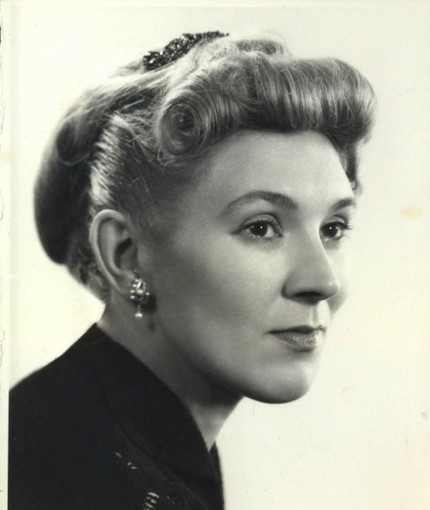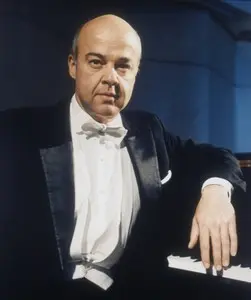
Halina Czerny-Stefańska |
Halina Czerny-Stefańska

More than half a century has passed since the day when she came to the Soviet Union for the first time – she came as one of the winners of the 1949 Chopin Competition that had just ended. First, as part of a delegation of masters of Polish culture, and then, a few months later, with solo concerts. “We do not know how Czerny-Stefanska plays the music of other composers, but in the performance of Chopin, the Polish pianist showed herself to be a filigree master and a subtle artist, who is organically close to the wonderful world of the great composer’s unique images. Galina Czerny-Stefańska had an outstanding success with the demanding Moscow audience. The arrival of the young pianist in the Soviet Union introduced us to a wonderful musician, before whom a great artistic path is open.” So wrote the magazine “Soviet Music” then. And time has confirmed this prediction.
But few people know that the first and most memorable meeting of Cherny-Stefanskaya with the Soviet people took place several years before the one in Moscow. It happened at a time when it seemed to the future artist that her cherished dream – to become a pianist – would no longer come true. From a young age, everything seemed to favor her. Until the age of ten, her father led her upbringing – Stanislav Schwarzenberg-Cherny, professor at the Krakow Conservatory; in 1932 she studied for several months in Paris with A. Cortot himself, and then, in 1935, she became a pupil of the famous pianist Y. Turczynski at the Warsaw Conservatory. Even then, she played on the stages of Poland and in front of the microphones of the Polish Radio. But then the war began, and all plans collapsed.
… The year of victory has come – 1945. This is how the artist herself recalled the day of January 21: “Soviet troops liberated Krakow. During the years of the occupation, I rarely approached the instrument. And that evening I wanted to play. And I sat down at the piano. Suddenly someone knocked. The Soviet soldier carefully, trying not to make any noise, put down his rifle and, choosing his words with difficulty, explained that he really wanted to listen to some music. I played for him all evening. He listened very carefully…”
On that day, the artist believed in the revival of her dream. True, there was still a long way to go before its implementation, but she ran it swiftly: classes under the guidance of her husband, teacher L. Stefansky, victory in the Competition for Young Polish Musicians in 1946, years of study in the class of 3. Drzewiecki at the Warsaw Higher School of Music ( first at its preparatory department). And in parallel – the work of an illustrator at a music school, performances at Krakow factories, at a ballet school, playing at dance evenings. In 1947, Czerny Stefańska performed for the first time with the Krakow Philharmonic Orchestra conducted by V. Berdyaev, playing Mozart’s Concerto in A major. And then there was a victory at the competition, which marked the beginning of a systematic concert activity, the first tour in the Soviet Union.
Since then, her friendship with Soviet listeners was born. She comes to us almost every year, sometimes even twice a year – more often than most foreign guest performers, and this already testifies to the love that the Soviet audience has for her. Before us is the entire artistic path of Cherny-Stefanskaya – the path from a young laureate to a recognized master. If in the early years our criticism still pointed to some mistakes of the artist who was in the process of becoming (excessive pathos, inability to master the large form), then by the end of the 50s we recognized in her merit a great master with her own unique handwriting, subtle and poetic individuality, marked by a depth of feeling, purely Polish grace and elegance, capable of conveying all shades of musical speech – lyrical contemplation and dramatic intensity of feelings, philosophical reflections and heroic impulse. However, not only we recognized. No wonder the great connoisseur of the piano H.-P. Ranke (Germany) in his book “Pianists Today” wrote: “In Paris and Rome, in London and Berlin, in Moscow and Madrid, her name has now become a household name.”
Many people associate the name of the Polish pianist with the music of Chopin, to which she gives most of her inspiration. “An incomparable chopinist, gifted with a wonderful sense of phrase, soft sound and delicate taste, she managed to convey the very quintessence of the Polish spirit and dance beginning, the beauty and expressive truth of Chopin’s cantilena,” Z. Drzewiecki wrote about his beloved student. When asked if she considers herself a Chopinist, Czerny-Stefanska herself answers: “No! It’s just that Chopin is the most difficult of all piano composers, and if the public thinks that I am a good Chopinist, then for me this means the highest approval. Such approval was repeatedly expressed by the Soviet public, expressing the opinion of which, M. Teroganyan wrote in the newspaper “Soviet Culture”: “In the world of piano art, as in any other art, there can be no standards and samples. And that’s why no one will come up with the idea that Chopin should be played only the way G. Cerny-Stefanska plays him. But there can be no two opinions about the fact that the most talented Polish pianist selflessly loves the creations of the brilliant son of her homeland and with this love for him captivates her grateful listeners. To confirm this idea, let us refer to the statement of another specialist, critic I. Kaiser, who admitted that Czerny-Stefanskaya “has her own Chopin – brighter, more individual, fuller than that of most German pianists, more free and unsteady than American pianists, more smoother and more tragic than the French.”
It was this convinced and convincing vision of Chopin that brought her worldwide fame. But not only that. Listeners from many countries know and appreciate Cerny-Stefanska in the most diverse repertoire. The same Dzhevetsky believed that in the music of the French harpsichordists, Rameau and Daken, for example, “its performance acquires exemplary expressiveness and charm.” It is noteworthy that recently celebrating the XNUMXth anniversary of her first appearance on the stage, the artist played with the Krakow Philharmonic along with Chopin’s Concerto in E minor, Frank’s Symphonic Variations, Mozart’s concertos (A major) and Mendelssohn’s (G minor), once again proving her versatility. She skillfully plays Beethoven, Schumann, Mozart, Scarlatti, Grieg. And of course, their compatriots. Among the works performed by her in Moscow at different times are the plays by Szymanowski, The Great Polonaise by Zarembski, The Fantastic Krakowiak by Paderewski and much more. That is why I. Belza is doubly right when he called her “the most remarkable Polish pianist after the “queen of sounds” Maria Szymanowska”.
Czerny-Stefanska took part in the jury of many competitions – in Leeds, in Moscow (named after Tchaikovsky), Long-Thibault, named after. Chopin in Warsaw.
Grigoriev L., Platek Ya., 1990





